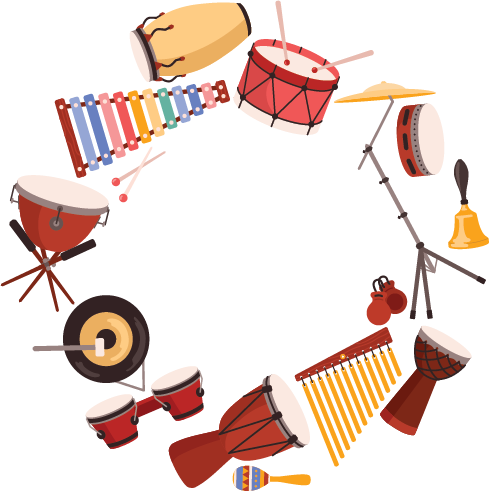
Prep lesson 32. Rhythm performance
- Woodblock Difficulty:
 Prior learning: None
Prior learning: None
![]() Students will develop their ability to differentiate between beat and rhythm through movement and body percussion.
Students will develop their ability to differentiate between beat and rhythm through movement and body percussion.

![]() Lyrics
Lyrics
What's on your dinner plate? You must find it hard to wait.
Rice, bread, pasta, meat. Is it time to stop and eat?
- Begin by singing “What’s on your Dinner Plate?” as a class while marching to the beat around the room.
- Remind students of the difference between beat and rhythm.
- Call out “Beat” or “Rhythm” at random intervals. When “Beat” is called, students continue marching steadily to the beat. When “Rhythm” is called, they adjust their steps to match the song's rhythm.
- Experiment with variations, such as stopping and clapping instead of marching or incorporating body percussion.
- Invite students to suggest creative body percussion patterns, such as snapping, patting, or stomping, and use them during the activity.
 Success Criteria
Success Criteria
- I can march to the beat of the song while singing.
- I can adjust my movements to match the rhythm when prompted.
- I can suggest and perform body percussion patterns.
![]() Students will collaborate to create and perform a rhythmic composition using visual and physical tools.
Students will collaborate to create and perform a rhythmic composition using visual and physical tools.
- Divide the class into four groups and give each group four paper plates.
- Each student selects a fruit/vegetable card to represent their contribution to the group’s “dinner.”
- Ask each group to arrange their plates in a line, placing their selected fruit/vegetable card on their plate. Groups decide on the order of the cards, creating their rhythmic composition.
- Guide the groups to speak through their composition rhythmically in sequence, ensuring they articulate each word clearly.
- Once confident, have them clap the rhythm of their composition together as a group.
- Encourage groups to perform their compositions for the class, showcasing their creativity and rhythmic collaboration.
- Wrap up by discussing how each group worked together and how rhythm can be created through simple, everyday items.
 Success Criteria
Success Criteria
- I can choose a fruit/vegetable card and place it in my group’s composition.
- I can work with my group to arrange our composition logically.
- I can speak and clap my group’s composition rhythmically.
![]()
Students will use non-melodic percussion instruments to create and perform rhythmic compositions, culminating in a collaborative class performance.

- Provide each student with a non-melodic percussion instrument.
- Have them play their group’s rhythmic composition together, focusing on staying in time and maintaining a steady rhythm.
- Encourage each group to experiment with different arrangements, such as everyone playing simultaneously, each person playing their part individually or splitting into smaller combinations (e.g., two at a time).
- Emphasise the importance of a seamless flow without gaps between sounds.
- Begin by singing “What’s on your Dinner Plate?” as a class, followed by the first group performing their composition.
- Return to singing the song before moving to the next group’s performance. Continue this pattern, alternating between singing and group performances, until all groups have had their turn.
- Conclude the performance by singing the song together one final time.
 Success Criteria
Success Criteria
- I can play a non-melodic percussion instrument in my group’s composition.
- I can decide on and perform an arrangement with my group that flows without gaps.
- I can participate in a class performance in rondo form.
![]()
Students will explore the difference between beat and rhythm, including rests, through a visual and interactive clapping game.
- Draw a large circle on the whiteboard resembling a clock face. At each hour point, place a crotchet [ta] representing a long note.
- Explain that the clock represents the beats of a rhythm, and clap slowly around the circle with the students, maintaining a steady beat.
- Transform some ta's into quavers [ti-ti's] representing short notes.
- Clap around the clock again, clapping the rhythm instead of the steady beat.
- Erase a few points on the clock and explain that these represent rests. Clap around the clock again, leaving the blank points silent.
- Gradually erase more points, increasing the challenge as students have to remember where the rests occur.
- As the game progresses, increase the speed of the clapping, testing the students’ ability to maintain accuracy while adapting to the evolving rhythm.
 Success Criteria
Success Criteria
- I can clap the beats of the rhythm clock accurately.
- I can adapt my clapping to include rhythms with long and short notes.
- I can observe and clap correctly, including silent beats for rests.
![]() Students will practise playing rhythms on instruments while distinguishing between different note values using a rhythm clock.
Students will practise playing rhythms on instruments while distinguishing between different note values using a rhythm clock.
 Success Criteria
Success Criteria
- I can identify long sounds and short sounds on the rhythm clock.
- I can play the assigned instrument for my chosen note value.
- I can follow and maintain the rhythm of the group.
- Redraw the rhythm clock on the board, filling it with a new combination of long and short notes.
- Assign one type of instrument to the long notes and a different type to the short notes (e.g., tambourines for long notes, claves for short notes).
- Allow each student to choose the instrument corresponding to the note length they want to play.
- Go around the rhythm clock together, clapping and playing the assigned instruments to match the rhythm.
- Repeat the activity, gradually increasing the tempo to add a level of challenge.
- Emphasise teamwork, as students need to stay in time with one another while focusing on their parts.
![]()
By identifying and avoiding a specified " poison rhythm," students will develop their ability to listen carefully, recognise rhythmic patterns, and respond appropriately.
 Success Criteria
Success Criteria
- I can echo back rhythms by clapping accurately.
- I can recognise the poison rhythm and avoid clapping it.
- I can listen attentively and stay in the game.
- Begin by clapping a simple rhythm and asking students to echo it back by clapping.
- Repeat this with various rhythms to warm up and ensure students are confident in following patterns.
- Introduce the concept of a "poison rhythm," a specific rhythm they must not clap back.
- Demonstrate it a few times so everyone knows which rhythm is "poison."
- Continue clapping rhythms for the students to echo back, occasionally including the poison rhythm. If a student claps the poison rhythm, they are "out" and sit down.
- Keep the game going by gradually increasing the complexity of the rhythms or speeding up the pace. The game will continue until one winner successfully avoids clapping the poison rhythm.
Suggested lessons
Y1. Beat II

Y1. Beat III

Y1. Beat IV

